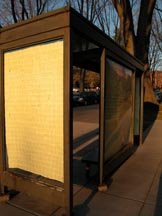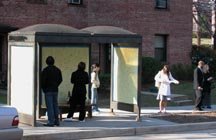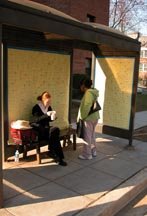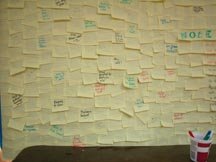 At around 5:45 this afternoon the Post-It notes came down. In retrospect, I believe they still should have come down before noon – the bus stop in Glover park only functions as an environment in the mornings when relatively large masses wait for every bus. In the evenings the converse occurs; it is where the masses come to descend.
At around 5:45 this afternoon the Post-It notes came down. In retrospect, I believe they still should have come down before noon – the bus stop in Glover park only functions as an environment in the mornings when relatively large masses wait for every bus. In the evenings the converse occurs; it is where the masses come to descend. Art is something that makes us recall our environment and see it from a different perspective. Art involves a transformative process, an awakening, moment of clarity, or moment of bewilderment, that re-contextualizes the known. It is why a representational painting is so easy to identify as “art.”
 We acknowledge the surface the image is painted on, we identify that it is an image providing the illusion of a deeper space, we identify that it is made by a hand, and then we abandon these concepts quickly to judge the quality or effectiveness of the representation. It is this last moment that becomes the sticking point in art appreciation: when judgment overrides discovery. Art is about discovery, and sometimes the acknowledgement of that discovery.
We acknowledge the surface the image is painted on, we identify that it is an image providing the illusion of a deeper space, we identify that it is made by a hand, and then we abandon these concepts quickly to judge the quality or effectiveness of the representation. It is this last moment that becomes the sticking point in art appreciation: when judgment overrides discovery. Art is about discovery, and sometimes the acknowledgement of that discovery.It was the moment of discovery that was most appealing to witness this morning. A man walking hurriedly to the bus stop this morning stopped in the middle of 41st street the moment he recognized something was different with the bus shelter. Granted, this is not necessarily the moment one recognizes art, only difference. It was the people who chose to enter the bus stop. Part of the function of the “wall paper” being hung only on the interior was so that people would have to enter the space to get the true sense of the content and the texture.
 One man drove past in a pickup truck and did a u-turn. He parallel parked and got out of his truck to inspect the piece. Some people left notes. Most did not. Some chose to ignore the nature of the Post-Its, perhaps afraid of the discovery. One woman sat contentedly eating a cup of yogurt while waiting for the bus, perhaps not changing her daily routine to read what was around her.
One man drove past in a pickup truck and did a u-turn. He parallel parked and got out of his truck to inspect the piece. Some people left notes. Most did not. Some chose to ignore the nature of the Post-Its, perhaps afraid of the discovery. One woman sat contentedly eating a cup of yogurt while waiting for the bus, perhaps not changing her daily routine to read what was around her. Nothing overly prophetic was scrawled on the pieces of paper. Most were just the absent reminders of things to do in the passing of the days or weeks to come.
 The richness is that these thoughts are not as disposable as the pieces of paper we place them on – they are important enough to write down. These notes acknowledge the overwhelming busyness we succumb to. You could summarize it as Christo and Jeanne-Claude meets Post-Secret. But that only
The richness is that these thoughts are not as disposable as the pieces of paper we place them on – they are important enough to write down. These notes acknowledge the overwhelming busyness we succumb to. You could summarize it as Christo and Jeanne-Claude meets Post-Secret. But that only describes what it looks like,
and not the true nature
of the beast.





